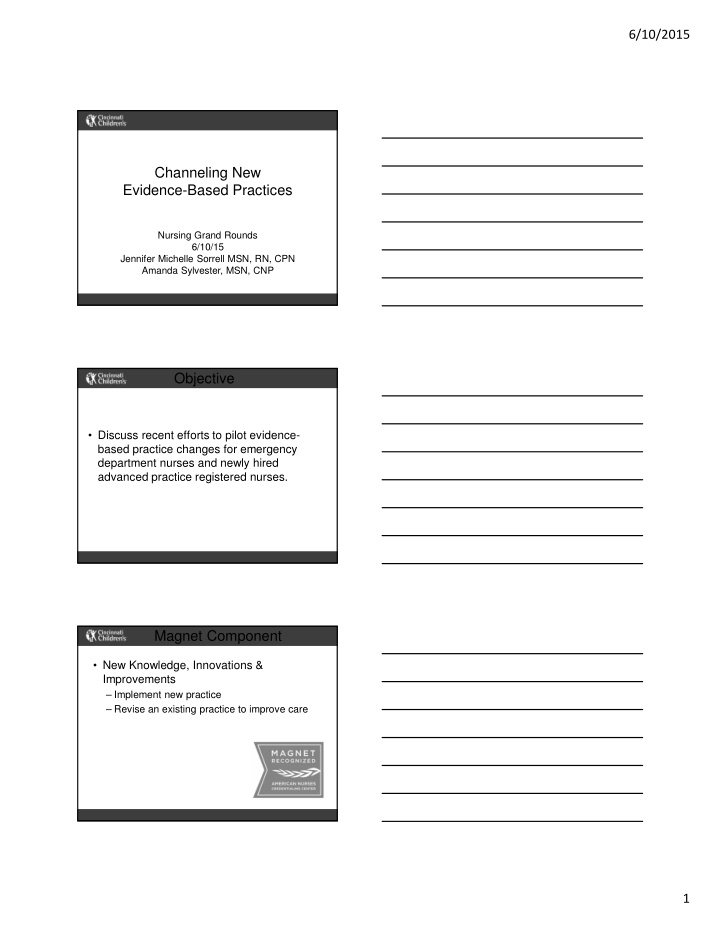



6/10/2015 Channeling New Evidence-Based Practices Nursing Grand Rounds 6/10/15 Jennifer Michelle Sorrell MSN, RN, CPN Amanda Sylvester, MSN, CNP Objective • Discuss recent efforts to pilot evidence- based practice changes for emergency department nurses and newly hired advanced practice registered nurses. Magnet Component • New Knowledge, Innovations & Improvements – Implement new practice – Revise an existing practice to improve care 1
6/10/2015 Purposeful Nurse Rounding in the Emergency Department Jennifer Michelle Sorrell, MSN, RN, CPN �������������������� ������� Purposeful Rounding in the Emergency Department Jennifer Michelle Sorrell, RN Objectives • Identify barriers to satisfaction in the Emergency Department. • Describe a recent evidence based practice implemented in the Emergency Department at Liberty. 2
6/10/2015 Clinical Issue – Patient/Family Satisfaction has emerged as an important issue – Rounding has been identified as a way to impact satisfaction – Increased length of stay in the ED – Communication has been identified as an important driver to enhance satisfaction and experience. – Nurse rounding with patients can only facilitate communication PICOT Question P Patients and Families in the Emergency Department I Purposeful Rounding with Nurses C Comfort rounding O Patient Experience Search Strategy • Keywords – Patient Satisfaction – Emergency Department – Emergency Patients – Patient Experience – Nurse rounding • Databases – PubMed – CINAHL • Children’s Hospital Association discussion board – Wesley Medical Center 3
6/10/2015 Findings 12 articles Citation Grade Nurse rounding has been identified as a way to improve satisfaction Forde-Johnston (2014) 1b in the emergency department Halm (2009) 1b (Woodard, 2009; Meade et al., 2006; Meade (2006) 3a Kennedy et al., 2013; Kelly & Faraone, 2013; Morton (2014) 4a Baker, 2012; Blakley et al., 2011; Tea et al., 2008; Kelly (2013) 4a Bourgault el al., 2008; Halm, 2009). Woodward (2009) 4a Bourgault (2008) 4a All with the exception Tea (2008) 4a Of one article found An increase in patient Emerson (2013) 4b Satisfaction when Kennedy (2013) 4b Rounding was Baker (2012) 4b Implemented. Blakley (2011) 4b 1 Children’s Health Association responses – Increased scores for Gallop Poll Evidence Synthesis • Nurse rounding has been identified as a way to improve satisfaction (Woodard, 2009; Meade et al., 2006; Kennedy et al., 2013; Kelly & Faraone, 2013; Baker, 2012; Blakley et al., 2011; Tea et al., 2008; Bourgault el al., 2008; Halm, 2009). • Implemented rounding in ED’s and found an increase in patient satisfaction (Morton, 2014; Kelly, 2013; Emerson, 2013; Baker,2012) • Implemented one and two hour rounding and found higher satisfaction scores post rounding with hourly rounding producing higher scores, however pre scores were also higher on those units (Meade, 2006) • Rounding using a script or specific measures was implemented to create purposeful rounding (Kelly, 2013; Bourgault, 2008; Tea,2008; Baker, 2012) Recommendation It is strongly recommended that patients receiving care in the emergency department participate in purposeful nurse rounding to improve patient/family satisfaction (Forde-Johnston, 2014 [1b]; Halm, 2009 [1b]; Meade, et al., 2006 [3a]; Bourgault et al., 2008 [4a]; Kelly & Faraone, 2013 [4a]; Morton et al., 2014 [4a]; Tea et al., 2008 [4a]; Baker, 2012 [4b]; Blakley et al., 2011 [4b]; Emerson et al., 2013 [4a]; Kennedy et al., 2013 [4b]; Woodard, 2009 [4b]). 4
6/10/2015 Implementation • Met with Practice Council in January 2015 • Proceed with Quality Improvement Project • Met with ED Point of Care Coordinating Council March 9, 2015 • First test of change, implementation of rounding, February 11, 2015 Implementation • Using quality improvement methods, nurses in the Emergency Department round with patients/caregivers with a predicted length of stay > 2 hours. During rounding nurses address pain, review expectations/plan of care, and address delays in care and concerns. A rounding log was documented on by nursing Evaluation • Some progress was made, the highest percentage was 21% of caregivers/patients participated in rounding with RNs • Although audit tool was not widely used nurses reported communication with caregivers/ patients about plan of care, delays, and pain • Nurses will continue to work on ways to improve communication with caregivers and patients in order to improve experience in the ED. 5
6/10/2015 Barriers to Satisfaction Strategic Plan • Safety and Care Coordination & Outcomes by improving communication with patients and families and ensure plan of care known, delays/concerns addressed, and pain assessed. Safety 2012 National Patient Safety Goals: • Improve staff communication with patients/families • Identify education needs • Identify patient safety risks 6
6/10/2015 Quality Magnet Component –Exemplary Professional Practice Value • Health care team aware of expectations by patient/caregiver and can better communicate around those expectations “Our strategic plan is centered on the child Whether you are coming from around the corner or from the other side of the world, it is gratifying to take your child to a hospital that is so deliberately focused on carefully defined improved medical outcomes — and is holding people accountable for delivering those improved outcomes. We just want our kids to get better.” Kay Fricke Parent Coordinator, Family Advisory Council 7
6/10/2015 Current Process Map Quick triage Patient registration reg by enters ED Walk-in ESR Roomed squad MD Evaluation Primary Dispo Interventions RN /reassessments assess Insert Name of Failure Why Why Lack of Satisfaction in the ED Why Waiting for Unknown Why Lack of communication Lack of consistency for reasons for wait Why ��������� �������� ��������������� �������������� No set expectations for communication with patient/family ������������������� Root Cause �������������������� ������� Key Driver Diagram ���������������������������� ����������� ������������������� ����������������� available information why waiting ��������� Increase the Education percentage of Pain assessments documentation accurate patients participating in purposeful Nurses engaged in rounding in Liberty rounding ED from 0 to 50% Scripting for Nurses by May 1, 2015 participating in rounding Patients/Caregivers ���������� engaged Increase the pt/caregivers reported satisfaction scores ��� above benchmark ��������������������������������������������� scores by 10% ���������������������������������������������� consistency in the ED ������ ������������������������������������������������������������������������� 8
Recommend
More recommend